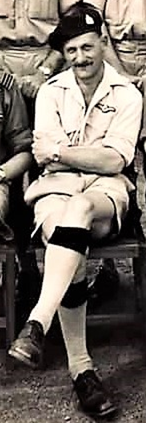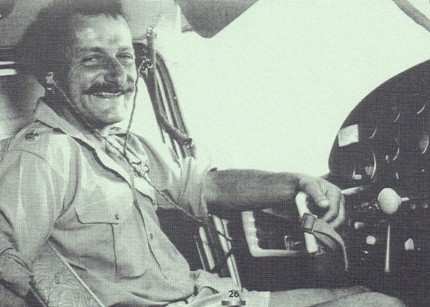View entry
Name: BEARCROFT, Michael Wales 'Punch' MBE


Photo Source: Buffalo Barua 7; David Reeve
Nee: son of Harold Wales Bearcroft
Birth Date: 3 July 1924 Nairobi
Death Date: 27 June 2004 Nairobi
Last Date: 2004
Profession: Pilot; Police
Area: Molo
Married: 1958 Nola Lamont Brown b. 1930 (dau of Albert Edward Brown)
Children: John
Book Reference: Pembroke, Wed, EA & Rhodesia, Campling, mini-Sitrep XXV
School: Framlingham College
General Information:
Punch Bearcroft was born on 3 July 1924 and after primary education in Kenya, went to Framlingham College in Suffolk. His first job back in Nairobi was with Cable and Wireless where he developed a keen interest in radio. He joined the Kenya Regiment for training in 1942 and then opted for transfer to the Royal Corps of Signals. After demobilisation in 1945 he took up farming in the Molo area but, as a 21 year old with no agricultural qualification, his salary of 200 shillings a month was insufficient to sustain the lifestyle he had enjoyed on HM's payroll. So to augment his pay he took on the additional job of travelling around the country buying stock for other farmers. A neighbour, who was a former RAF Instructor, convinced him that getting around in a small aircraft would be much more profitable. So, on 14 April, 1947 he presented himself at Keith Campling's hangar for his first lesson with this neighbour, Bill Duirs. He made rapid progress and on 25 July passed the A licence test which was conducted by Capt. Caspareuthus who told him what to do - figures of eight, a stall, a spin and a forced landing- and then retired to the Aero Club bar while Punch got on with it. Thereafter, flying became the dominant activity in Punch's life.
On 4 December 1947 he managed to buy his first plane — a new J3Cub for £670- which proved to be an excellent investment - and enabled him to graduate to a Piper Cruiser some months later. In April 1949 he flew to England in the Cruiser (now registered VP-KF5) to do an advanced course at Broxbourne. The Chief Flying Instructor, a war-time pilot, taught him aerobatics, formation flying, instrumentation as well as certain combat techniques that civilian pilots do not need to know but proved very useful in the Emergency. Upon returning to Kenya he started taking aerial photographs for an Air Survey company and met his wife, Nola, who, on 'walk-about' from New Zealand had joined the company as a camera operator.
Punch was one of the first to join the Kenya Police Reserve Air Wing when it was formed in 1949. It was a tiny unit comprising a few Reserve Police Officers who were pilots and aircraft owners and it was mainly involved in communication and reconnaissance work.
When the Emergency was declared Punch was called up and posted to Nakuru to become part of the first three pilot Flight with Peter Welby and Ronny Proctor. Shortly after the declaration of the Emergency "I" Force under Lt. Neville Cooper was based at Squair's Farm and Hammy O'Hara, the "I" Force signaller, contacted the Police Airwing at Nakuru to advise them that the airstrip adjoining the farm was serviceable. The following day Punch arrived to find Hammy very frus-
trated in his attempts to contact a patrol by 88 set. Punch offered to try from the air and found no problem in contacting the patrol. Later that day Neville Cooper, an old friend and former next door neighbour, explained to Punch that his small patrols into the forest could be much more effective if the did not have to carry heavy supplies over rough terrain. The following day Punch was formally attached to "I" Force and started working with Nev Cooper to develop tactics for air support. From mid-November 1952 "I" Force was able to mount patrols operating deep into the mountain forests for up to ten days at a time communicating to base via a Police Airwing aircraft which also dropped much needed food and other supplies. As a result of this support "I" Force achieved considerable success against the Mau Mau gangs. In January 1953, "I" Force was reinforced by the arrival of some twenty National Service men who had just returned from six months' training in Southern Rhodesia and it became I Company with air support increased to four Piper Cub planes. Punch also started experimenting with methods of bombing with homemade bombs (Gog and Magog), of dropping 7 second delay grenades and of straffing with Sten guns mounted on the wings. These activities occasionally resulted in some hair-raising and life threatening incidents which have since become legend in the annals of the Kenya Regiment.
The success achieved by the Kenya Regiment resulted in the provision of Airwing support for other British battalions, and at the height of the Emergency Punch was running the airflight at Nyeri with 11 aircraft and fifteen pilots. He readily admitted that the Kenya Regiment was his fa-
vourite unit and their patrols certainly favoured him, above all others, as their support pilot. Not only did he have an uncanny ability to locate patrols deep in the forest but his flying skill was quite amazing. Even in challenging weather conditions he would sweep in below tree-top level when making his drops. He was so accurate that on one occasion his drop actually broke the leg of a man in the receiving party and on another he dropped a supply of rice straight into a cooking pot.
Following the end of the Emergency the whole of the Police Airwing moved to Nairobi taking over a hangar from the old East African Airways. In 1963 Wing Commander Francombe retired and Punch somewhat reluctantly gave up his job as Operational Commander to assume overall command of the Kenya Police Airwing. As Commandant he directed progress during a period when the Airwing became much more professional. It started operating twin engine aircraft, includ-
ing a ten-seater Grand Commander, the old Pipers were replaced by Cessnas; later on two helicopters were purchased which Punch much enjoyed flying.
In 1977 Michael Bearcroft, the greatly respected Commandant of the Kenya Police Airwing and Assistant Commissioner of Police, retired. He was loaded with honours which included the MBE, the Colonial Police Medal, Mentions in Dispatches and the Kenya Head of State's Commendation. He started commercial flying — initially selling GA aircraft throughout Africa, then undertaking air survey work which he much enjoyed, and finally, freelance charter until 1990. At the age of
75 he was still flying his own C150 taildragger on a Private Pilots Licence until health problems forced him to replace it with a 4WD Toyota and go fishing at Watamu. During the course of his 50 year love affair with flying he had flown more than 17000 hours in over 70 different aircraft — yet his favourite remained the old DC3- the Dakota.
Punch lost his right hand in a motor cycle accident when he was a young man but he overcame the challenges presented by this disability with immense determination and ingenuity. His mother was a great horse master and Punch not only rode races in her colours but also show jumped her horses. He was an accomplished water skier. He repaired radios, was an excellent mechanic and a competent lathe operator. On one occasion he had trouble with the outboard mo-
tor of his boat in rough seas but with just one hand and a Swiss army knife he repaired the carburettor in very difficult conditions. Even in his later years his ability to untangle a knotted fishing line or to thread a needle was regarded with amazement by watching friends. Despite these many talents, however, Punch will be most remembered for his laughter, his generosity of spirit and his fun-loving sense of humour. One of his many party tricks was to challenge anyone to blow them-
selves higher than he could by lighting a thunderflash then covering it with a metal dustbin lid and standing on top of it.
Punch was Guest of Honour at the Kenya Regiment's 65th Anniversary Dinner at Watamu in 2002 and he gave a fascinating and amusing account of how the Kenya Regiment and the Kenya Police Airwing had combined during the Mau Mau emergency. There is no doubt that a great many of the Kenya Regiment members who served in the Mau Mau emergency will remember him with affection, gratitude and awe. His skill as a flier was unique. Consider the challenges presented by flying a plane at treetop level in a high mountain valley in misty weather conditions and then throwing out supply packages with superb precision— and doing it all with just one hand. How does one describe such a man? Intrepid? Resourceful? Audacious? Devil-may care? Fearless? Heroic?
